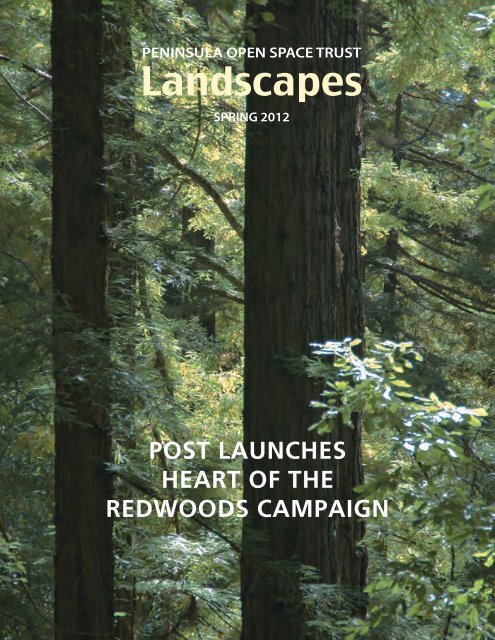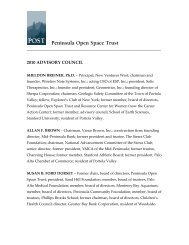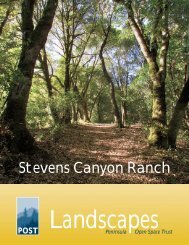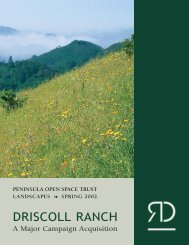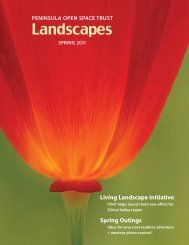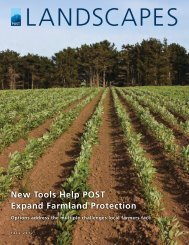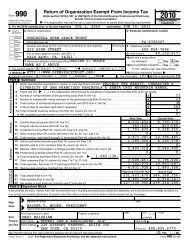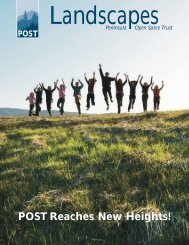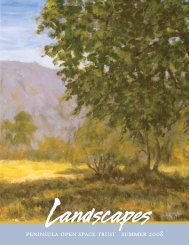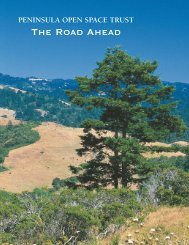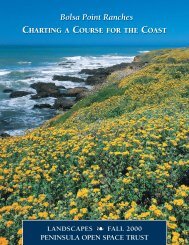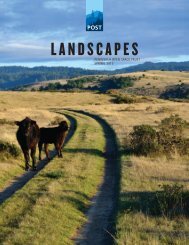Download a PDF - Peninsula Open Space Trust
Download a PDF - Peninsula Open Space Trust
Download a PDF - Peninsula Open Space Trust
Create successful ePaper yourself
Turn your PDF publications into a flip-book with our unique Google optimized e-Paper software.
PENINSULA OPEN SPACE TRUSTLandscapesSPRING 2012POST LaunchesHEART OF THEREDWOODS CAMPAIGN
Help Save Our Redwood ForestsOnce located throughout the northern hemisphere, redwoods now exist in onlythree places on the planet—including right here in our own Santa Cruz Mountains.POST’s Heart of the Redwoods Campaign is our $50 million effort to protect20,000 acres of stunning local redwood forests over the next five years. The future of thesemajestic trees is at stake. We must act quickly to preserve what’s left of our redwood forestsbefore they are gone for good.Rare, Iconic and At RiskOn the West Coast, redwoods grow in a 50-mile-wide strip of land from the Oregon borderto Big Sur. Our local redwoods give us quiet, peaceful places for rejuvenation and recreationjust minutes from Silicon Valley. They are a symbol of California and essential to the healthand vitality of our region.Population growth and development pressures are threatening these ancient giants.The temptation to carve up our redwood forests into private, luxury estates is great. If weallow this to happen, these forests will be destroyed and our quality of life compromised.We can’t let that happen. Our Heart of the Redwoods Campaign will allow us to respondimmediately to the most urgent threats.Bear Creek Redwoods © 2011 Ann DuweLittle Basin © 2007 Dan QuinnLittle Basin © 2007 Dan Quinn
Gibson and Nola Duwe © 2012 Ann Duwe © 2012 Karl Kroeber© 2012 Karl KroeberMarbeled murrelet © CourtesyCalifornia Dept. of Fish & GameSave the forest. . . for the treesRedwoods inspire awe in all of us, connecting usdirectly to our region’s natural heritage. They alsoplay an important role in maintaining healthy ecosystems.By creating effective, science-based conservation plansfor each property we protect through this campaign,we will ensure that large expanses of redwoods and theprecious old growth they contain remain permanentlyprotected.. . . for the waterRedwood forests keep our creeks and streams clean byproviding a barrier to pollution and preventing erosionalong stream banks. They also help preserve the qualityof our local drinking water and replenish waterways withcoastal fog drip captured by their fine needles.. . . for the wildlifeRedwoods are home to fascinating and threatenedwildlife. Some animals, such as mountain lions, needlarge expanses of forest land to thrive, while the marbledmurrelet, an endangered bird, relies on coastal habitatin tall trees such as redwoods for survival. Diminishingpopulations of Coho salmon, steelhead and trout rely onclear waterways flowing through redwood habitat....for the peopleRedwood groves are the perfect escape from hecticurban life. They provide a magical setting forinspiration and recreation, connecting people with nature.Once protected, our local redwood forests will help linkmore than 100,000 acres of open space, trails and parklandincluding four major state parks—Big Basin, CastleRock, Butano and Portola Redwoods. These forests alsocounteract the destructive forces of global warming,filtering greenhouse gases out of the air we breathe andenhancing the land’s ability to adapt to climate change.4 ■ LANDSCAPES
The Path to ProtectionPOST is developing strong relationships with theowners of the most significant privately held redwoodproperties in the Santa Cruz Mountains. Our ultimategoal through this campaign is to protect these landsthrough fee purchase or conservation easement.These properties tie in directly to collaborativework POST is already doing with our Living LandscapeInitiative (LLI) partners—the Land <strong>Trust</strong> of Santa CruzCounty, The Nature Conservancy, Save the RedwoodsLeague, and Sempervirens Fund. Many of the projects tobe funded through our campaign will result from jointexpertise and partnership through the LLI. That meansthe redwood properties we save will get the benefit ofmultiple stakeholders working hard to ensure theirpermanent protection.Purchase of CEMEX Redwoods, 8,532 acres of forestland near Davenport, was not only the first step towardrealization of our Heart of the Redwoods Campaigngoals, but also the beginning of changes in the verynature of how POST practices conservation. All five LLIorganizations are creating new stewardship strategies tomake up for the lack of public agency capacity to take onlong-term care and management of open lands. POST isat the forefront of changes in the nature of conservation,redefining what it means to save land.Half Moon BayPescaderoWoodsideHEART OF THEREDWOODSAREALos GatosWith respect to redwood forest lands, POST hascarefully examined the benefits of retaining workingforests where they already exist, such as at CEMEXRedwoods. Few properties are large enough to beworking forests, and where appropriate, POST will firstprotect the land’s natural resources, introduce restorationmeasures where needed and, only after these objectivesare satisfied, set aside areas for strictly regulatedsustainable harvest.This Is Our Last ChanceThis campaign is an incredible opportunity for localconservation, and POST is uniquely equipped to carryit out. Our staff is extremely knowledgeable about theregion and about redwoods. Over the past 35 years, POSThas completed large, complex land deals. And we havea successful track record of tapping the power of theprivate and public sectors to finance land purchases whenopportunities arise.Your support is fundamental to protecting what’s leftof our magnificent redwood heartland. Our goal for theHeart of the Redwoods Campaign is to save 20,000 acres,including a handful of very large properties that are keyto our ability to connect them all. Connectivity will keepour redwood forests viable, allowing them to sustain theoriginal natural abundance of the Santa Cruz Mountains.Together we can ensure these iconic giants, which shapedour past and are critical for our future, remain a treasurein our own backyard. ■© 2012 Karl KroeberProtectedRedwood ForestUnprotectedRedwood ForestSanta Cruz MountainsBonny DoonDavenportSanta CruzTo find out more about POST’s redwood campaignand how you can get involved, please callPOST Director of Major Gifts Kathleen Phan at(650) 854-7696, x303. Thank you!SPRING 2012 ■ 5
Evelyn Tilden Mohrhardt GiftsHelp Protect Redwoods© 2012 Karl KroeberFifteen years ago, Evelyn Tilden Mohrhardt, then in her90’s, passed away. She left her sizable estate in the careof The San Francisco Foundation, which has generouslydirected gifts to POST since 1981. A recent gift of $50,000from the foundation’s Mohrhardt trust helped POST purchaseCEMEX Redwoods, the first property included in our Heartof the Redwoods Campaign.The CEMEX Redwoods project was impressive to thefoundation because of its collaborative nature. “We lovePOST,” says Francesca Vietor, program officer for theenvironment at The San Francisco Foundation. “When ourdonors see that we support POST, they want to support it,too. The Mohrhardt trust is among the advised core trustswe have that honor a donor’s specific wishes,” she says.Trees Became a Passion“Like many people who came of age during the 1930s,Evelyn never viewed herself as wealthy,” says friend MichaelHelms. “She was completely unpretentious and unassuming.”Helms says Evelyn volunteered as a candy striper forSt. Francis Hospital in San Francisco for decades. A longtimeresident of the city, she spent her later years in amodest house in San Anselmo, surrounded by lots of trees.Evelyn came from a distinguished line of characters.Her grandfather, Harvey Blood, helped build a toll roadover Ebbett’s Pass in the Sierra. Nearby Mt. Reba was namedfor Evelyn’s mother, Reba Grosse. At one time Harvey alsoowned the Murphys Hotel, a major stopover for dignitariesvisiting the Calavaras Big Trees in Arnold. As a young girl,Evelyn and her sister spent summers in the region, ridingand fishing at will. “It was a time of exquisite freedom,” saidHelms, “creating connections with the natural world thatstayed with Evelyn for life.”Evelyn’s immediate family made frequent trips fromSan Francisco to Big Basin to enjoy the redwoods.In midlife she spent a year traveling the world with hergrandmother. Eventually she settled into a quiet life.She dedicated her estate to the things she loved most—redwood trees and wild creatures that need protection. ■6 ■ LANDSCAPES
Managed Forests:Putting Conservation FirstOver the past 35 years, POST has helped protectthousands of acres of redwood forest. In thethree counties where POST works, very littleredwood forest is original—all but isolated stands oftrees have been logged.Surrounding these protected forests, such as BigBasin Redwoods State Park, are thousands of acres ofsecond-growth redwood forest that provide criticalconnections between protected lands and offer multiplebenefits. These privately owned forests also containremnant old-growth trees.Private and unprotected from fragmentation, thesesecond-growth forests are located on a handful of largeproperties that have been sustainably managed throughtwo or three harvest cycles. The result is a new forestthat is recovering from the era of clear-cuts. Throughcareful management, these trees are gradually developingthe diversity in size and age more characteristic ofnatural forests.Sustainable Management“We live in a human-influenced landscape. Eventhe old-growth trees have lost their original context,”says Paul Ringgold, POST’s vice president of landstewardship. “We can’t create a wilderness, where wildfireand lightning strikes can burn at will, for example.Management of second-growth forest allows us opportunitiesto restore habitat lost withthe clearing of the virgin forest.We can protect and add buffersaround remnant patches of oldforest. We can protect fragileplant and animal habitat. At thesame time we can provide forrecreational uses that don’tinterfere with habitat or withwater resources, and we canimprove resistance to wildfire,”says Paul.For forest land acquiredthrough POST’s Heart of theRedwoods Campaign, our vision is to allow harvestingonly where sustainable management is already beingpracticed. As with CEMEX Redwoods, POST will firstconduct a thorough review of all the natural features onthe property. Fragile habitat, including all old-growthtrees, creeks and streams, archeological and other specialresources will be protected. No original forest will becut. Restoration, such as removing dams to allow forfish passage, will be done as well. Only when these stepshave been taken will areas be identified for possible harvest,and then only under conservation restrictions thatare even greater than those in place today.“The Santa Cruz Mountains are the birthplace ofprogressive, sustainable techniques for redwood forestmanagement,” says Paul. “Developed in the 1960s, thesemethods focus on careful selection of individual treesfor harvest from clumps of redwoods. The techniqueincreases the growth rate of the remaining trees.Adds Paul, “We are extremely fortunate in thatsustainable forest management is already practiced bythe large property owners with whom we work. Theselandowners have chosen to harvest well below the legallimits, which are the most stringent in California.”Properties secured through POST’s Heart of theRedwoods Campaign will receive even greater protection.Conservation easements POST places on them will putconservation values first and foremost. ■SECOND-GROWTH STANDSTAND AFTER SELECTIVE HARVESTSPRING 2012 ■ 9
NEWS UPDATESFormer POST Property Becomes National ParklandRancho Corral de Tierra was a 4,262-acre jewel in POST’s Saving the Endangered Coast campaign crown. As of December,3,800 acres of this property have been added to the Golden Gate National Recreation Area. One of the largest undevelopedexpanses on the <strong>Peninsula</strong>, Rancho Corral de Tierra features scenic views, headwaters to four watersheds, habitats for adiverse population of plants and animals, and key connections between the California Coastal Trail and Bay Area Ridge Trail. ■Rancho Corral de Tierra © 2010 Robert John WhiteHendrys Creek ©2012 MROSDPOST Acquires Hendrys CreekProperty in Los GatosAt the end of January, POST completed its two-part acquisition of a117-acre property in Los Gatos. The land is heavily forested with a mixof large trees, including some Douglas-fir. Steeply rising slopes are dottedwith chaparral and sagebrush, and trout have been spotted in HendrysCreek, which runs the full length of the property.Former owner Sal Carilli says one of his favorite things about theproperty is the amount of water on it. In addition to a 100-foot waterfall anda trio of falls that appear when it rains, Carilli says there are about 25 springsthere. At one time the property was registered as a place to get free drinkingwater. “People tell me I have such good health because of the water,” says theactive 85-year-old.POST purchased the property for $1.5 million and is holding it untilthe Midpeninsula Regional <strong>Open</strong> <strong>Space</strong> District (MROSD) can takeownership. MROSD bought adjacent parcels from Carilli in the past andwould like to add this land to the Cathedral Oaks Area of the Sierra Azul<strong>Open</strong> <strong>Space</strong> Preserve. ■Barrett Creek Uplands JoinsSierra Azul <strong>Open</strong> <strong>Space</strong> PreservePOST purchased the 158-acre Barrett Creek Uplands property in March2010. MROSD has been managing the property since then and, inDecember 2011, assumed ownership of the land from POST for $250,000.In addition to providing excellent habitat for wildlife and adding anotherpiece to the Sierra Azul <strong>Open</strong> <strong>Space</strong> Preserve, Barrett Creek Uplands is partof the Alamitos Creek watershed area that MROSD and the Santa ClaraValley Water District are working together to protect. ■10 ■ LANDSCAPES
NEWS UPDATESPOST Transfers Madonna Creek Ranchand October Farm to MROSDMadonna Creek RanchFor more than 15 years POST has owned Madonna Creek Ranch,a 564-acre coastal property near Half Moon Bay containinggrassland, prime agricultural land and beautiful ocean views fromthe ridge tops. In March of this year the property was transferredto MROSD for $600,000. The land will become part of theMiramontes Ridge <strong>Open</strong> <strong>Space</strong> Preserve, and MROSD will workto improve habitat for local wildlife, including yellow warblers,golden eagles and the threatened California red-legged frog. ■Madonna Creek Ranch © 2007 POSTOctober Farm © 2011 POSTOctober FarmIn March, MROSD purchased October Farm from POST for$3.5 million. POST acquired the 266-acre Coastside propertyin July 2011, and MROSD has managed it in the interim.The former cattle ranch and produce farm is an importantcomponent of the Lobitos Creek watershed—includingspawning grounds for steelhead trout—and will be part ofMROSD’s long-term planning for the adjacent Purisima Creek<strong>Open</strong> <strong>Space</strong> Preserve. ■POST HostsBlue House Farm CSAThe Blue House Farm Community SupportedAgriculture (CSA) program, based in Pescaderoon POST-protected land, provides organic, locallygrown seasonal fruits and vegetables to its members.Flowers, eggs, raw honey and other items can beadded at additional cost to a member’s weeklydistribution. POST headquarters at 222 High Streetin downtown Palo Alto is one of many pick-uplocations for Blue House Farm CSA deliveries. Visitbluehousefarm.csaware.com/store for details. ■CSA box © 2012 Blue House FarmSPRING 2012 ■ 11
NEWS UPDATESPOST Welcomes Two Board MembersOne new and one returningBoard member joined thePOST leadership team in January— Dennis DeBroeck of PortolaValley is new, and Robert (Bob)Kirkwood of Palo Alto returns aftera “sabbatical” of two years.© 2012 Paolo VesciaDennis DeBroeckThe <strong>Peninsula</strong>’s open land was apowerful lifestyle magnet for DennisDeBroeck. He moved here in 1976after growing up in Colorado wherehe developed a love of the outdoors.From a rental house in Portola ValleyRanch he had a view of Windy Hilland could walk right out the dooronto beautiful trails. He vowed thenthat if he ever could, he would livein Portola Valley. By 1989 Dennisand his wife, Nancy Heinen, becamepermanent Portola Valley residents.A view of Windy Hill and trails theycan walk to are still as importantas ever.Now a senior partner at Fenwick& West, Dennis has entrepreneurialand managerial experience as alawyer. He has worked with companiesthrough all phases of their life cycles.He has also been in leadershippositions in successful law firms,beginning with his own firm,established in 1980.“In a sense the region took shapebefore I arrived,” says Dennis. “TheI-280 corridor divided denselydeveloped areas from the open land—your professional life from yourprivate, recreational life. In the 35years since then, density has increasedeast of 280. Thanks to the good workof POST and other organizations, theland west of the corridor retains muchof its original character.”Robert KirkwoodMaybe it’s axiomatic that if you’rehighly involved in volunteer workduring your professional career, you’llcontinue to be so in retirement.For Bob Kirkwood of Palo Alto thatis definitely the case. Bob retired in2000 as director of government andeducation affairs for Hewlett-Packard.© 2010 Ann DuweHis volunteer resumé wasalready distinguished. After 12 yearson the POST Board, Bob took a shortsabbatical, returning in January.In 1979, when POST was afledgling organization, Bob wasrecruited to the first AdvisoryCouncil because of his broadexperience in statewide environmentalissues as well as his legal expertisein land-use planning. His firstBoard term began in 1998 andconcluded in 2010. During thattenure, Bob was involved indeveloping strategies to managePOST-protected land.What drew him back? “Inaddition to having a congenialgroup of people with whom to work,I am most happy to have a small partin the many projects on the horizon,”said Bob. “The organization hasmatured, and it is time now to helpdevelop an innovative new vision forPOST. I look forward to helping shapethat vision and put it into practice.”For years Bob has helped shapestatewide conservation policy andpromoted cooperation betweengovernment and private agencies.He formerly served as chairmanof the California State CoastalConservancy. Besides his work withPOST, Bob currently holds advisorypositions with the <strong>Trust</strong> for PublicLand and is a member of the boardof the Sierra Nevada Conservancy.He is co-chair of the Santa ClaraCounty Partnership for SchoolReadiness and chairman of theBella Vista Foundation, a familyfoundation that works to improveearly childhood development. ■12 ■ LANDSCAPES
NEWS UPDATESBrad O’Brien:From Volunteer to Board ChairThe path to POST Board Chairis a logical progression forBrad O’Brien of Menlo Park. Asenior partner in real estate andenvironmental practice at WilsonSonsini Goodrich & Rosati in PaloAlto, Brad was appointed to thePOST Board in July 2007, and asof January succeeds Mark Wan ofWoodside as Board Chair.Brad’s interest in POST grewout of his interest in protecting openspaces close to work and home. Heand his wife, Judy, a <strong>Peninsula</strong> native,have been POST donors since 1991.In 2001 Brad was chosenVolunteer of the Year in recognitionof innumerable hours he providedas a pro bono attorney for POST.Because of his experience in complexlegal transactions, he was able toassist POST in the ten-year processof transferring Rancho Corral deTierra to the National Park Service.He also had a major role in theagreements surrounding POST’sprotection of Bolsa Point Ranchesand Mindego Hill. Most recentlyBrad’s help was indispensable innegotiating the purchase CEMEXRedwoods.“When I joined the Board,I was eager to reach out to mycontemporaries about the benefitsof supporting POST,” said Brad.“Now, I am more concerned aboutengaging the next generation. Theolder group had roots in the region.They are far more sensitized to thethreat of losing scenic open space.The younger group is highly awareof global threats such as climatechange and loss of biodiversity, andit is POST’s new challenge to findways to make the next generationmore aware of how these broaderissues play out here,” he says. ■© 2012 Douglas Peck© 2012 Paolo VesciaPOST Welcomes New Vice Presidentof Acquisition Tricia SuvariIn February, attorney Tricia Suvarijoined POST as vice presidentof acquisition and general counsel.With more than 20 years ofexperience in a wide variety ofcomplex transactions, includingreal estate work, Tricia will overseethe acquisition, leasing and transferof POST properties.Some of the unique challengesfacing POST are the combinationsof local zoning laws, burgeoningpartnerships, long-standing legalissues and the economy’s effect onland-transfer opportunities, saysTricia. Her journey to POST reflectsa consistent interest in science andnature, beginning with a Bachelorof Science degree in geology andgeophysics from Yale College. Afterreceiving her degree from HarvardLaw School, Tricia worked for alarge law firm in Los Angeles doingreal estate transactions, then movedinto the world of biotechnology.She held various senior legal staffpositions at Genentech, then servedas general counsel at CV Therapeutics.She has provided consultingservices to other biotechnologycompanies and serves as a boardmember or consultant to severalnonprofit organizations, includingChrist Church, an Episcopal parishin Portola Valley and Woodside.In keeping with her previousroles, Tricia says she wants to“change the world in a positiveway. I want to be part of somethingthat has an impact.” The job atPOST opened a way to merge herprofessional talents withher love of the outdoors. “Havingthe opportunity to combine thesethings feels like a gift,” she says. ■SPRING 2012 ■ 13
Marion Softky Remembered:Environmental Chronicler, Eyewitness to ChangeIn 40 years of reporting for The Almanac, Marion Softkykept a keen eye on public and private decisions with farreachingconsequences for the local landscape. By reportingaccurately, intelligently and often, she traced the changes thatmade the <strong>Peninsula</strong> different from any other metropolitanarea in the world. Her writing informed readers, who in turnbecame the critical mass needed to support change.Marion, an early POST donor, passed away in December ofcomplications from abdominal cancer. She was 84.In the closing months of her life she was at work on ahistory of turning points that kept the <strong>Peninsula</strong> from becominganother Los Angeles. She began with the master plan for SanMateo County. Adopted in 1960, the plan envisioned massiveurban development covering everything from Skyline Boulevardto the bay and even well into the bay. Enormous freeways wereto connect the new cityscape with an equally ambitious buildoutalong the coast. Marion identified a dozen issues that rose upto transform the future as laid out in that master plan.“My own experience in San Mateo County showed howcomplex and how interesting such social/political evolutioncan be,” she wrote. In private she continued to relate howgrateful she was for the opportunity to meet the people on allsides of the issues and question them at length. Among thevery big ideas that did not happen — shaving off the top ofSan Bruno Mountain tocreate 26 square milesof new flat land in thebay, and building twodams in Pescadero toprovide drinking waterfor the coast’s newpopulation.Said Marion, “Each issue had its leaders and foot-soldiersand opponents. And many true heroes emerged in this fight tosave our future.” She counted the late Mel Lane in his role asthe first chairman of the Bay Conservation and DevelopmentCommission as one of those leaders. POST, along with Savethe Bay and the Midpeninsula Regional <strong>Open</strong> <strong>Space</strong> District,figured prominently on Marion’s list of organizations that werefundamental to creating a landscape with generous open spaces.Marion, who had bachelor’s and master’s degrees inphysics, was a master of the interview. It mattered not whethershe was questioning royalty, celebrities, scientists with arcanedisciplines or Koko the gorilla. Marion found ways to makethe story live in the minds of local readers. She covered POST’sdevelopment, drawing attention to the significance of our landsavingwork. And she found the threads that connected it all.She will be greatly missed. ■© 2009 Marja Sadoughi, Courtesy The AlmanacWalk in the WildDjerassi Sculpture ToursThe Djerassi Resident Artists Program (DRAP) sitson a 580-acre Woodside property where a POSTconservation easement protects the land’s naturalbeauty. DRAP is offering two types of tours for 2012:• Director’s Tours: Visit more than 25 sculpturesand the Artists’ Barn on this 3-mile hike led byDRAP Executive Director Margot H. Knight.Bring a bag lunch for a picnic stop. $50 perperson, payable to DRAP.Five tours from May through September.• Two-Mile Tours: Visit 15 sculptures on thisfree tour led by DRAP staff. Seven tours fromJune through October.Advance reservations required. Tours are on unpavedtrails and involve significant elevation gains. ContactDRAP for reservations and more information:(650) 747-1250 or www.djerassi.orgDialog by Roland Mayer © Todd Holloway14 ■ LANDSCAPES
LANDSCAPESSPRING 2012<strong>Peninsula</strong> <strong>Open</strong> <strong>Space</strong> <strong>Trust</strong>222 High StreetPalo Alto, CA 94301(650) 854-7696www.openspacetrust.orgNON-PROFIT ORG.U.S. POSTAGEPAIDSAN FRANCISCO, CAPERMIT NO. 925Address Service RequestedFront cover: Little Basin © 2007 Dan QuinnVisit our Redwoods Campaign on the WebThere’s so much to share aboutour Heart of the RedwoodsCampaign that we’ve created aspecial section on the POSTwebsite. See photos highlightingthe beauty of these majestic treesand learn more about POST’sefforts to protect them:www.openspacetrust.org/lands/redwoodsMap lovers, rejoice! Take a tour ofour online maps to see redwoodlands that still need protection andhave the potential to connect toexisting parkland:www.openspacetrust.org/lands/redwoods/map


